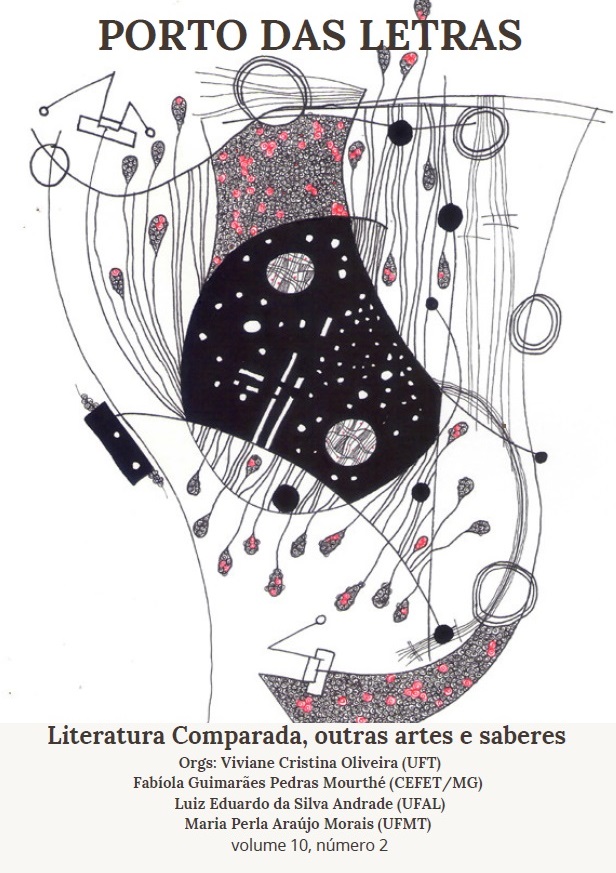O NASCIMENTO E A MORTE DO MUNDO
O RÉQUIEM TRÁGICO DE DOIS IRMÃOS
DOI:
https://doi.org/10.20873.24201Abstract
Following the interdisciplinary spirit proposed and defended by Eneida Maria de Souza as Comparative Literature’s very structure, we here propose a speculative-philosophic hermeneutic approach to Dois Irmãos (HATOUM, 2023), a novel whose lyrical form we try to understand through the poetically strategic formal function of Nael, the narrator. By dialoguing with important papers dedicated to Hatoum’s novel, such as those of Vidal Filho (2018) and Holanda (2020), we underline our approach’s specificity by making its center of interest what we call the World’s sclerosis, an expression with which we aim to capture Dois Irmãos’s tragic form. Developing such an hermeneutic insight, we unfold a conceptual figure which we call the originary phenomenological structure, by which World and consciousness constitute themselves reciprocally, as they are formalized in the third level of language. At last, we set our own thinking in dialogue with Heidegger’s reflections from Die Sprache (2018), in order to better understand how the three elements, World, consciousness and language are set together though Miltoun Hatoum’s novel, whose formal constitution we call a tragic-lyric one.References
ASSIS, M. Dom Casmurro. São Paulo: Penguin & Companhia das Letras, 2016.
ARISTÓTELES. De arte poética. In: Operum omnium volumen primum. Porto Alegre: Instituto Hugo de São Víctor, 2016.
HEIDEGGER, M. (1927/2006) Sein und Zeit. Tübingen: Walter de Grutyer.
HEIDEGGER, M. Unterwegs zur Sprache. Frankfurt am Main: Vittorio Klostermann, 2018.
HEIDEGGER, M. Der Ursprung des Kunstwerks. In: HEIDEGGER, Martin, Holzwege. Frankfurt am Main: Vittorio Klostermann, 2003.
HOLANDA, L. Milton Hatoum: um norte novo na literatura contemporânea. In: CESAR MAIA, E. Realidade Inominada: ensaios e aproximações. Recife: CEPE Editorial, 2019.
JAEGGER, W. Paideia: a formação do homem grego. Tradução de Arthur M. Parreira. São Paulo: WMF Martins, 2013.
MELLO, R. Uma casa de ossos e palavras: Nael e a arquitetura de uma metáfora em Dois irmãos, de Milton Hatoum. In: Ícone. Volume 19, n.2, p. 129-144, dez 2019.
MARQUES, Â.; MARQUES, A C. Um rosto para Domingas: hospitalidade e reconhecimento na criação narrativa de uma identidade feminina em Dois Irmãos, de Milton Hatoum. In: IPOTESI, v.21, n.1, p.46-63, jan/jun-2017.
NOGUEIRA-PRETTI, (2020). Dois Irmãos, de Milton Hatoum: versões de homem cordial. In: Fórum de Literatura Brasileira Contemporânea, Vol. 21, p. 163-87, Dez 2018.
Sartre, J-P. L’être et le néant: essai d’ontologie phénoménologique. Paris: Gallimard, 1976.
SANTOS, K. A representação histórica em Dois Irmãos, de Milton Hatoum. In: Revista de Letras,Vol. 16, N. 18, p. 1-13, 2014.
SOUZA, E. Literatura Comparada/Indisciplina. In: Em tese, Belo Horizonte, Vol. 20, N. 3, p.119-126, set-dez 2014.
VIDAL FILHO, E. Nael, herdeiro testamentário: a terceira margem da gemelidade em Dois irmãos, de Milton Hatoum. In: Fórum de Literatura Brasileira Contemporânea, Vol. 21, p. 2-39, 2018.
Downloads
Published
How to Cite
Issue
Section
License
Os autores concordam com os termos da Declaração de Direito Autoral, que se aplicará a esta submissão caso seja publicada nesta revista (comentários ao editor podem ser incluídos a seguir).

